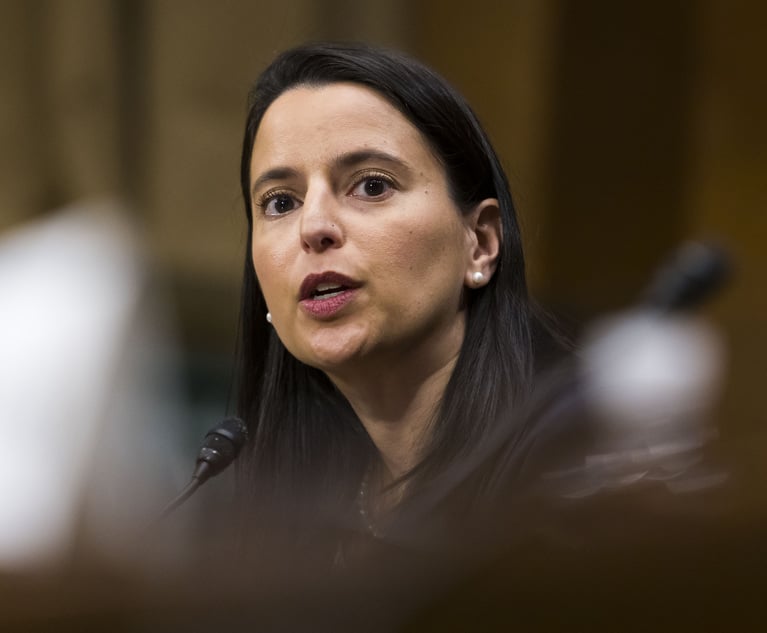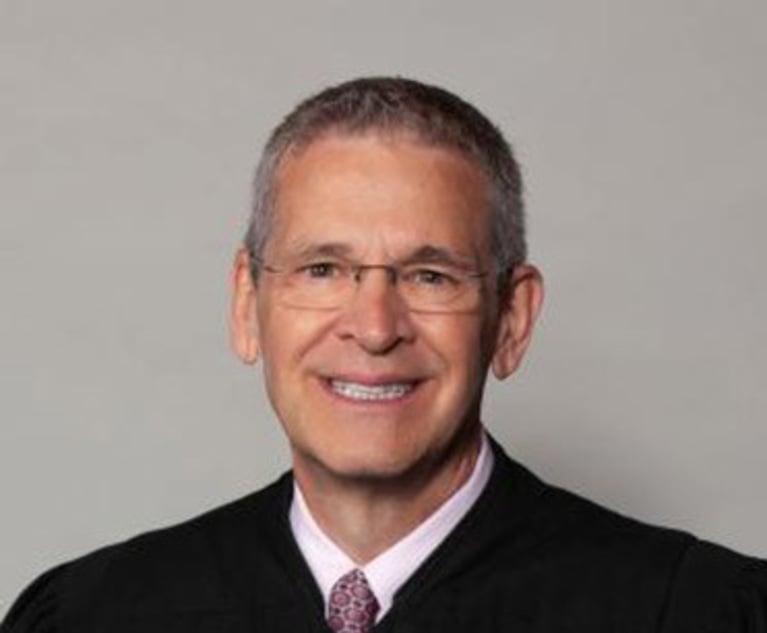Ninth Circuit Judges Consider Trump's Move to Make Asylum-Seekers Wait in Mexico
A three-judge panel of the court allowed advocates more than twice the allotted 30 minutes for arguments in a case challenging the Trump Administration policy to force asylum seekers from Central America to wait in Mexico for their cases to be heard.
April 24, 2019 at 04:43 PM
4 minute read
 U.S. Court of Appeals for the Ninth Circuit. Photo: Jason Doiy/ ALM
U.S. Court of Appeals for the Ninth Circuit. Photo: Jason Doiy/ ALM
Three judges from the U.S. Court of Appeals for the Ninth Circuit wrestled with the complexities of federal asylum law Wednesday as they considered whether to extend an emergency stay of a lower court ruling blocking a Trump Administration policy to force asylum seekers from Central America to wait in Mexico for their cases to be heard.
U.S. District Judge Richard Seeborg blocked the Trump administration's “Migrant Protection Protocols” (MPP) on April 8, finding that policies were not authorized by Congress under the Immigration and Nationality Act and even had they been, they didn't meet the government's obligation to avoid returning any alien to a territory where his or her “life or freedom would be threatened.”
The Ninth Circuit panel that heard Wednesday's arguments—Judges Diarmuid O'Scannlain, William Fletcher, and Paul Watford—previously granted the government's April 12 request for an emergency stay of Seeborg's ruling, just prior to when the injunction was set to go into effect. That grant of the emergency stay would seem to have been a good sign for the administration. But Justice Department lawyer Scott Stewart faced tough questions from the panel about how government officials makes determinations of who is eligible to be routed through MPP proceedings.
Lawyers for the plaintiffs, a group of 11 individual asylum seekers and a collection of legal groups who represent immigrants in asylum proceedings, have argued that Congress excluded aliens who arrive at the border without proper documents—often asylum seekers—from those who could be returned to contiguous territories while awaiting their full removal.
Early in his arguments, the DOJ's Stewart said that the determination of whether to initiate full or expedited removal proceedings was one made by an individual immigration officer based on “an informed use of discretion.” But Fletcher said that the law had created two “separate and non-overlapping categories”—one eligible to be returned across the border and one not. “I'm not asking about procedures, I'm asking about categories,” Fletcher said. Fletcher noted that the text of the statute referred to two categories—one described as “other aliens.”
“Other' suggest that they're not the same,” Fletcher said.
Stewart responded that he accepted that there are two different categories, but who falls into what category isn't certain until an immigration officer has made the determination.
Staking out potential middle ground, Watford said that even if the government's procedures themselves were authorized, the fact that immigration officers do not affirmatively ask people who are subject to the new policy whether they fear a return to Mexico seems problematic—especially in light of the government's obligation under international treaties to protect asylum-seekers.
“How can you want to comply with your obligation without asking, 'Hey, by the way, before you return to Mexico do you have a fear of returning there?” Watford said.
“I don't see how that's not 'arbitrary and capricious,'” said the judge, hinting that the panel could find the policy in violation of the Administrative Procedures Act even if it finds that it was authorized by Congress.
Stewart asked that if that were the only legal flaw the panel finds in the protocols that the government be allowed to move forward with implementing the policy under a court order requiring that the question be asked.
The third member of the panel, O'Scannlain, reserved his most pointed question for Judy Rabinovitz, deputy director of the ACLU's Immigrants' Rights Project who represents the plaintiffs in the case.
Why, O'Scannlain asked, would Rabinovitz's clients “give up freedom in Mexico for mandatory detention in the U.S.?”
Rabinovitz responded that she and her colleagues had discussed the issue with all the individuals and told them that even if they were to win this case they still could be detained in the U.S. and potentially deported.
“They said we don't want to be in Mexico,” Rabinovitz said.
O'Scannlain followed up asking why return to Mexico would be more dangerous than potential deportation to their home countries.
“It may not be more dangerous, but it's still dangerous,” she said.
This content has been archived. It is available through our partners, LexisNexis® and Bloomberg Law.
To view this content, please continue to their sites.
Not a Lexis Subscriber?
Subscribe Now
Not a Bloomberg Law Subscriber?
Subscribe Now
NOT FOR REPRINT
© 2025 ALM Global, LLC, All Rights Reserved. Request academic re-use from www.copyright.com. All other uses, submit a request to [email protected]. For more information visit Asset & Logo Licensing.
You Might Like
View All
Latham Adds Former Treasury Department Lawyer for Cross-Border Deal Guidance
2 minute read
Zoom Faces Intellectual Property Suit Over AI-Based Augmented Video Conferencing
3 minute readTrending Stories
Who Got The Work
J. Brugh Lower of Gibbons has entered an appearance for industrial equipment supplier Devco Corporation in a pending trademark infringement lawsuit. The suit, accusing the defendant of selling knock-off Graco products, was filed Dec. 18 in New Jersey District Court by Rivkin Radler on behalf of Graco Inc. and Graco Minnesota. The case, assigned to U.S. District Judge Zahid N. Quraishi, is 3:24-cv-11294, Graco Inc. et al v. Devco Corporation.
Who Got The Work
Rebecca Maller-Stein and Kent A. Yalowitz of Arnold & Porter Kaye Scholer have entered their appearances for Hanaco Venture Capital and its executives, Lior Prosor and David Frankel, in a pending securities lawsuit. The action, filed on Dec. 24 in New York Southern District Court by Zell, Aron & Co. on behalf of Goldeneye Advisors, accuses the defendants of negligently and fraudulently managing the plaintiff's $1 million investment. The case, assigned to U.S. District Judge Vernon S. Broderick, is 1:24-cv-09918, Goldeneye Advisors, LLC v. Hanaco Venture Capital, Ltd. et al.
Who Got The Work
Attorneys from A&O Shearman has stepped in as defense counsel for Toronto-Dominion Bank and other defendants in a pending securities class action. The suit, filed Dec. 11 in New York Southern District Court by Bleichmar Fonti & Auld, accuses the defendants of concealing the bank's 'pervasive' deficiencies in regards to its compliance with the Bank Secrecy Act and the quality of its anti-money laundering controls. The case, assigned to U.S. District Judge Arun Subramanian, is 1:24-cv-09445, Gonzalez v. The Toronto-Dominion Bank et al.
Who Got The Work
Crown Castle International, a Pennsylvania company providing shared communications infrastructure, has turned to Luke D. Wolf of Gordon Rees Scully Mansukhani to fend off a pending breach-of-contract lawsuit. The court action, filed Nov. 25 in Michigan Eastern District Court by Hooper Hathaway PC on behalf of The Town Residences LLC, accuses Crown Castle of failing to transfer approximately $30,000 in utility payments from T-Mobile in breach of a roof-top lease and assignment agreement. The case, assigned to U.S. District Judge Susan K. Declercq, is 2:24-cv-13131, The Town Residences LLC v. T-Mobile US, Inc. et al.
Who Got The Work
Wilfred P. Coronato and Daniel M. Schwartz of McCarter & English have stepped in as defense counsel to Electrolux Home Products Inc. in a pending product liability lawsuit. The court action, filed Nov. 26 in New York Eastern District Court by Poulos Lopiccolo PC and Nagel Rice LLP on behalf of David Stern, alleges that the defendant's refrigerators’ drawers and shelving repeatedly break and fall apart within months after purchase. The case, assigned to U.S. District Judge Joan M. Azrack, is 2:24-cv-08204, Stern v. Electrolux Home Products, Inc.
Featured Firms
Law Offices of Gary Martin Hays & Associates, P.C.
(470) 294-1674
Law Offices of Mark E. Salomone
(857) 444-6468
Smith & Hassler
(713) 739-1250








